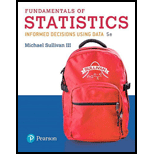
Concept explainers
| Outcome | Profit ($) | Probability |
| Straight flush | 200 | 12/5525 |
| Three of a kind | 150 | 1/425 |
| Straight | 30 | 36/1105 |
| Flush | 20 | 274/5525 |
| Pair | 5 | 72/425 |
| Other | −5 | 822/1105 |
| Source: http://wizardofodds.com/threecardpoker | ||
- a. What is the expected profit when playing the $5 pair plus bet in three card poker.
- b. If you play the game for 4 hours with an average of 35 hands per hour, how much would you expect to lose?
Want to see the full answer?
Check out a sample textbook solution
Chapter 6 Solutions
Fundamentals of Statistics (5th Edition)
Additional Math Textbook Solutions
Introductory Statistics (10th Edition)
Elementary Statistics Using The Ti-83/84 Plus Calculator, Books A La Carte Edition (5th Edition)
An Introduction to Mathematical Statistics and Its Applications (6th Edition)
Business Statistics: A First Course (7th Edition)
Statistics for Psychology
Elementary Statistics Using the TI-83/84 Plus Calculator, Books a la Carte Edition (4th Edition)
- Snake Eyes What ¡s the probability of rolling snake eyes ("double ones") three times in a row?arrow_forwardA poker hand, consisting of five cards, is dealt from a standard deck of 52 cards. Find the probability that the hand contains the cards described. (a) Five hearts (b) Five cards of the same suit (c) Five face cards (d) An ace, king, queen, jack, and a ten, all of the same suit (royal flush)arrow_forwardDividing a JackpotA game between two players consists of tossing a coin. Player A gets a point if the coin shows heads, and player B gets a point if it shows tails. The first player to get six points wins an 8,000 jackpot. As it happens, the police raid the place when player A has five points and B has three points. After everyone has calmed down, how should the jackpot be divided between the two players? In other words, what is the probability of A winning and that of B winning if the game were to continue? The French Mathematician Pascal and Fermat corresponded about this problem, and both came to the same correct calculations though by very different reasonings. Their friend Roberval disagreed with both of them. He argued that player A has probability 34 of winning, because the game can end in the four ways H, TH, TTH, TTT and in three of these, A wins. Robervals reasoning was wrong. a Continue the game from the point at which it was interrupted, using either a coin or a modeling program. Perform the experiment 80 or more times, and estimate the probability that player A wins. bCalculate the probability that player A wins. Compare with your estimate from part a.arrow_forward
 Algebra and Trigonometry (MindTap Course List)AlgebraISBN:9781305071742Author:James Stewart, Lothar Redlin, Saleem WatsonPublisher:Cengage Learning
Algebra and Trigonometry (MindTap Course List)AlgebraISBN:9781305071742Author:James Stewart, Lothar Redlin, Saleem WatsonPublisher:Cengage Learning Holt Mcdougal Larson Pre-algebra: Student Edition...AlgebraISBN:9780547587776Author:HOLT MCDOUGALPublisher:HOLT MCDOUGAL
Holt Mcdougal Larson Pre-algebra: Student Edition...AlgebraISBN:9780547587776Author:HOLT MCDOUGALPublisher:HOLT MCDOUGAL College AlgebraAlgebraISBN:9781305115545Author:James Stewart, Lothar Redlin, Saleem WatsonPublisher:Cengage Learning
College AlgebraAlgebraISBN:9781305115545Author:James Stewart, Lothar Redlin, Saleem WatsonPublisher:Cengage Learning Algebra & Trigonometry with Analytic GeometryAlgebraISBN:9781133382119Author:SwokowskiPublisher:Cengage
Algebra & Trigonometry with Analytic GeometryAlgebraISBN:9781133382119Author:SwokowskiPublisher:Cengage Glencoe Algebra 1, Student Edition, 9780079039897...AlgebraISBN:9780079039897Author:CarterPublisher:McGraw Hill
Glencoe Algebra 1, Student Edition, 9780079039897...AlgebraISBN:9780079039897Author:CarterPublisher:McGraw Hill





